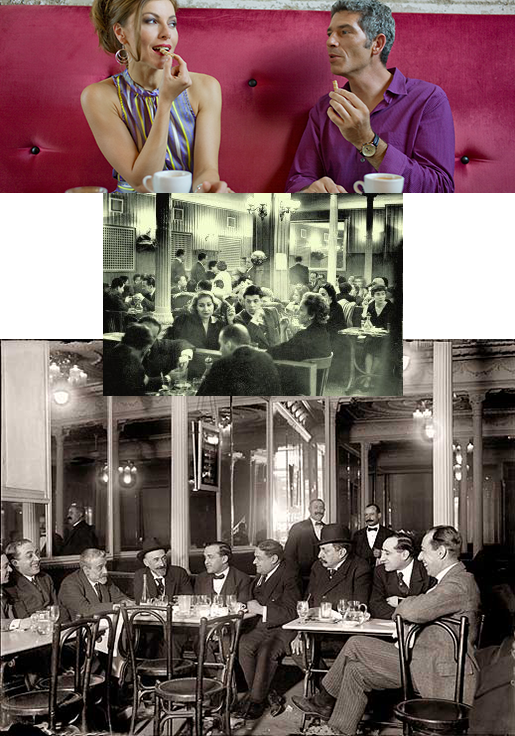Cartographies: some "mind maps" of my own and some of other people, the flows that the expatriates of “In Treatment” METALOCUS, have generated on the world map through our stories, and are the result of an amalgam of experiences between the Cartesian and the psychogeographical.

Natural architecture: resin brain blood vessels. Source: “The Mind Map Book”
How are these subjects related? Tony Buzan, a recognized scientist that studies the radiant thinking, and the ways to enhance the capacities of the mind, draw on numerous images of natural architecture to express the way how our brain reacts when it receives an external stimulus. If we drink a coffee cup for example, the answer of the brain is, at the same time, simple and amazingly complex. Each bit of information that access to the brain (scent, flavor, color, temperature) can be represented like a central sphere from which million connections could irradiate. Each link represents an association, and each association has its own and infinite network of bonds and connections.(1)
A mind map is an organizational chart that gathers through words, colors and drawings, all the important points of a subject, and shows its different relations, imitating therefore the way the brain processes the information, that established our natural way of thinking. Memory, concentration, logic and creativity are enhanced with this system of thought.(2)
Buzan suggests that to activate the cortical capacities through radiant thinking it is important to work using synesthesia, it means, a fusion of the physical senses. As the coffee has been taken as example to explain the radiant thinking, lets go ahead in this way. The idea of the coffee as a beverage, besides being a stimulant of the nervous system, handles undoubtedly with several senses; but fundamentally it drives me to the Cafe as a place.(3)

Mind map.
The culture of the Cafe-bar of the European society, that later moved to some Latin American cities in and hybrid way, is a practice that captivates me, especially the way how, it has recreated its urban archetypes for centuries through the routes along these warm places. The site of urban encounter par excellence is the Coffee, whether it is oeuvre of anonymous hands, as if has been recognized by the high architectonic culture or the avante-garde interior design.
The Cafe gives scale to a public space of social representativeness, of urban identity; it is a city door that allows acceding to a comfortable place that invites to the interchange between people. As a cultural pole or as a social condenser, the Cafe displays a series of tangible or intangible invariants that induce to the recognition of archetypal elements that makes the essence of its architectonic program have a close link with the city.(4)
The Cafe is definitively a typology for the senses. The inner atmosphere granted by the symbols that do its image, like the equipment, the illumination, the textures, the scents, the music, are elements that get impregnated in the individual memory while they gradually shape a collective memory. It is a really inspiring place that invites to an explosive production of ideas.

Coffee chats.
“There hasn’t been invented any better place for meeting as the Cafe: it is a neutral territory, (…) where nobody is a foreigner, because everybody is a foreigner indeed".(5) Even though the collaborators of “In Treatment” lived in different realities, we are part of tough global cultural changes that are reflected for example in the consumption habits and which manifests in the substitution of the traditional cafe by new commercial forms.
Nevertheless, I am sure that we still have the usual Cafe in which “…beyond the external gestures… as Portzamparc suggests in his worlds, a romance may be born, and groups shall entangle themselves in political arguments of in deep reflections about life and death, love and treason, pleasure and pain. If this is still possible the spirit which distinguishes the cafe from any other place is safe.”(6)
The diversity of the texts that have conformed this section, are a kind of anthology of provoking and stimulating internalizations/ externalizations. Each text seeks to transform the perception of global territories, from a personal territory, both redrawn with hybrid tactics and interfaces.
Now we are relieved, we get off the In Treatment sofa. We are going to have a coffee, to incubate our ideas, to stimulate our senses through the urban archetypes of each context and of our mind cartographies, searching for a new explosion of ideas. Till next season of In Treatment METALOCUS!
---
(1) BUZAN, Tony. “El libro de los mapas mentales: cómo usar al máximo las capacidades de la mente”. Ed. Urano. Barcelona. 1996. Pág. 63.
(2) Op. cit (2).
(3) It is used throughout the text, the word coffee with capital letters to refer to the site, and coffee with sensitive referring to the drink or grain.
(4) FERNÁNDEZ Quinteiro, Laura. “Arquetipos de una identidad urbana: cafés y bares montevideanos”. PhD Thesis, Universidad Politécnica de Madrid. 2010.
(5) CARANDELL, Luis. Prólogo en: DÍAZ, Lorenzo. “ Madrid: Tabernas, botillerías y cafés”. Ed. Espasa Calpe. Madrid. 1992.
(6) GROSSMAN, Luis. Prólogo en: MONTANARO, Hugo; et. al. “The best of bars and restaurants”. Ed. Kliczkowski Publisher. 1998. Pág. 10.
¡¡MORE!! > "TILL NEXT SEASON"
IN TREATMENT - METALOCUS.
DIRECTOR: JOSÉ JUAN BARBA. COORDINATION: INÉS LALUETA. ORGANIZATION: INÉS LALUETA, PEDRO NAVARRO. ENGLISH VERSION: KAREN SIMPSON. GUESTS FIRST SEASON: JOSÉ JUAN BARBA, MARINA DIEZ-CASCÓN, SERGIO DIEZ-CASCÓN SOLER, LARA FERNÁNDEZ GONZÁLEZ, CARLOS GERHARD PI-SUÑER, MONTSE PLA GARCÍA-CASTANY, XAVIER NICOLAU CUYÀS, FERNANDO RIAL PONCE, VERÓNICA ROSERO.






















